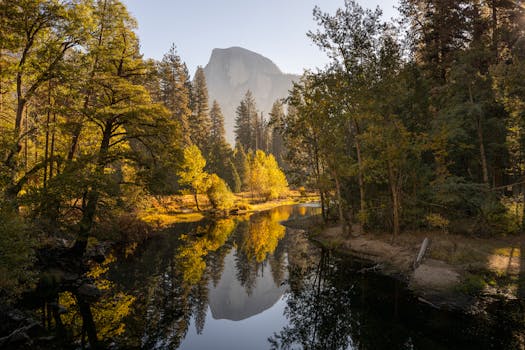Yosemite National Park: Do It Now
Yosemite National Park, located in California’s Sierra Nevada, is one of the most iconic and breathtaking natural destinations in the United States. Renowned for its dramatic granite cliffs, ancient sequoia trees, cascading waterfalls, and diverse wildlife, it spans over 1,100 square miles of protected wilderness. This UNESCO World Heritage Site attracts millions of visitors each year and offers a unique experience with every visit.
Beyond its stunning landscapes, Yosemite holds immense historical significance. The park played a crucial role in the development of the national park system in the United States, drawing inspiration from prominent figures like John Muir and the Yosemite Grant that President Abraham Lincoln authorized in 1864. Whether you have a passion for hiking, are a photographer in search of breathtaking landscapes, or simply wish to immerse yourself in the beauty of nature, Yosemite offers an exceptional retreat into the marvels of the great outdoors.
Highlights of Yosemite National Park
Yosemite is home to some of the most famous landmarks in the U.S., making it a must-visit for nature enthusiasts and adventurers alike. Here are some standout features that draw people from across the globe:
- El Capitan: This towering granite monolith is a favorite among rock climbers. Its vertical face presents a challenge like no other, with climbers from around the world attempting to ascend its majestic walls.
- Half Dome: Another iconic formation, Half Dome is famous for its unique shape and challenging hike. For those daring enough to climb it, the summit offers breathtaking panoramic views.
- Yosemite Falls: One of North America’s tallest waterfalls, Yosemite Falls is a sight to behold, especially during late spring when snowmelt fuels its powerful flow.
- Mariposa Grove: This area is home to some of the largest and oldest giant sequoias on Earth, including the Grizzly Giant, estimated to be over 2,000 years old.

Outdoor Activities for Every Adventurer
The park provides a vast array of activities catering to all levels of experience and interests. Regardless of whether your stay lasts just a day or stretches into a longer getaway, there are attractions and experiences to suit every taste.
- Hiking: With over 750 miles of trails, Yosemite offers routes ranging from easy walks like Bridalveil Fall Trail to strenuous treks like the Mist Trail leading to Vernal and Nevada Falls.
- Camping: Campgrounds such as North Pines and Tuolumne Meadows allow visitors to immerse themselves fully in nature. Reservations are often required well in advance.
- Wildlife Watching: The park’s diverse ecosystems are home to black bears, mule deer, bobcats, and hundreds of bird species. Always observe wildlife from a safe distance.
- Photography: From Tunnel View at sunrise to Glacier Point at sunset, Yosemite offers countless opportunities for capturing stunning natural beauty.
A Brief History of Conservation
The preservation of Yosemite as a national treasure began with President Abraham Lincoln signing the Yosemite Grant in 1864, setting aside Mariposa Grove and Yosemite Valley for public use and protection. This marked the first time land was designated for preservation in U.S. history. Later, John Muir’s passionate advocacy led to the establishment of Yosemite National Park in 1890.
Muir described Yosemite as “the most magnificent of all sacred sanctuaries of Nature,” emphasizing its profound spiritual importance and motivating conservation initiatives across the globe. Today, ongoing initiatives aim to preserve its delicate ecosystems while managing increasing visitor numbers responsibly.
Planning Your Visit
A trip to Yosemite requires thoughtful planning due to its popularity and seasonal variations. Here are some tips for making your visit smooth and memorable:
- Choose the Right Season: Spring (April-June) offers roaring waterfalls from snowmelt; summer (July-August) is ideal for camping but can be crowded; fall (September-November) brings vibrant foliage; winter (December-March) transforms the park into a snowy wonderland perfect for skiing at Badger Pass.
- Book Early: Lodging inside the park or nearby fills up months in advance. Secure accommodations as soon as possible if you plan to stay overnight.
- Packing Essentials: Bring layered clothing for changing temperatures, plenty of water, sturdy footwear for hikes, maps (cell service can be unreliable), and reusable containers to minimize waste.
- Respect Nature:Follow Leave No Trace principles by disposing of trash responsibly and reducing any disturbance to wildlife and their habitats.
Sustainability Efforts
The National Park Service is dedicated to protecting the natural environments of Yosemite while addressing the challenges posed by climate change and an increase in tourism. Efforts include habitat restoration projects, waste reduction programs like refillable water stations throughout the park, and educational initiatives encouraging sustainable practices among visitors.
While you are there, think about how you can contribute positively by supporting community projects, opting for reusable items instead of single-use plastics, and participating in any volunteer activities that might present themselves.
Yosemite National Park captivates visitors with its breathtaking vistas while fostering a profound connection to the untamed beauty and rich heritage of the natural world. Visiting this iconic destination is more than just a trip; it's an opportunity to witness firsthand why preserving such places matters profoundly for future generations.
For official information about planning your visit or learning more about ongoing conservation efforts, visit nps.gov.